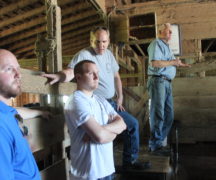With harvest season quickly approaching, the Wood County Farm Bureau offers some safety reminders as Farm Safety Week (Sept. 17-23) kicks off.
“Please slow down when you are approaching farm equipment from either direction,” said Amanda Barndt, president of the Wood County Farm Bureau. This includes but is not limited to combines, semis, tractors, grain carts, and tillage pieces.
If attempting to pass, be cautious and make sure the operator sees you and acknowledges your passing. It’s important to remember to triple-check oncoming traffic as well. “That large piece of machinery cannot stop on a dime, she said.
Logan Riker Chamberlain, vice president of the Wood County Farm Bureau, recommended drivers who are pulling off the road should check for mailboxes or telephone poles that the farm machinery may not be able to navigate through. “When it is dark out, use even more caution in passing as pieces and parts of the farm equipment might extend past the visible edge of the equipment and could catch you if passing too closely,” she said.
Be aware of slow-moving vehicle (SMV) signs—those reflective, red and orange triangular signs that signify a vehicle going 25 mph or less. “It’s important to keep a distance when following behind farm equipment or other vehicles with SMV signs,” Barndt explained. “The operators often have blind spots from the seat of those vehicles.”
“We understand it may be frustrating to slow your travel, but please understand those farmers are also trying to make it to their destination quickly, and most importantly–safely,” Riker Chamberlain said. “They have deadlines to meet, weather conditions to race, and families to get home too. It’s only a few months out of the year that they occasionally occupy the roads alongside us, but they are bringing in corn and soybeans among other crops to feed the ever-growing population.”
The two Farm Bureau members also asked parents of teenage drivers to take the time to discuss the information with their young drivers.
“It’s important to know that more than 90% of the 75,000 Ohio farms are family run,” Barndt said. “Yet today’s farmers are doing more with less. They would have needed 100 million more acres in 1990 to match current production levels. We appreciate the endless sacrifices you make racing deadlines, weather and being away from your families as you work to feed the world.”



